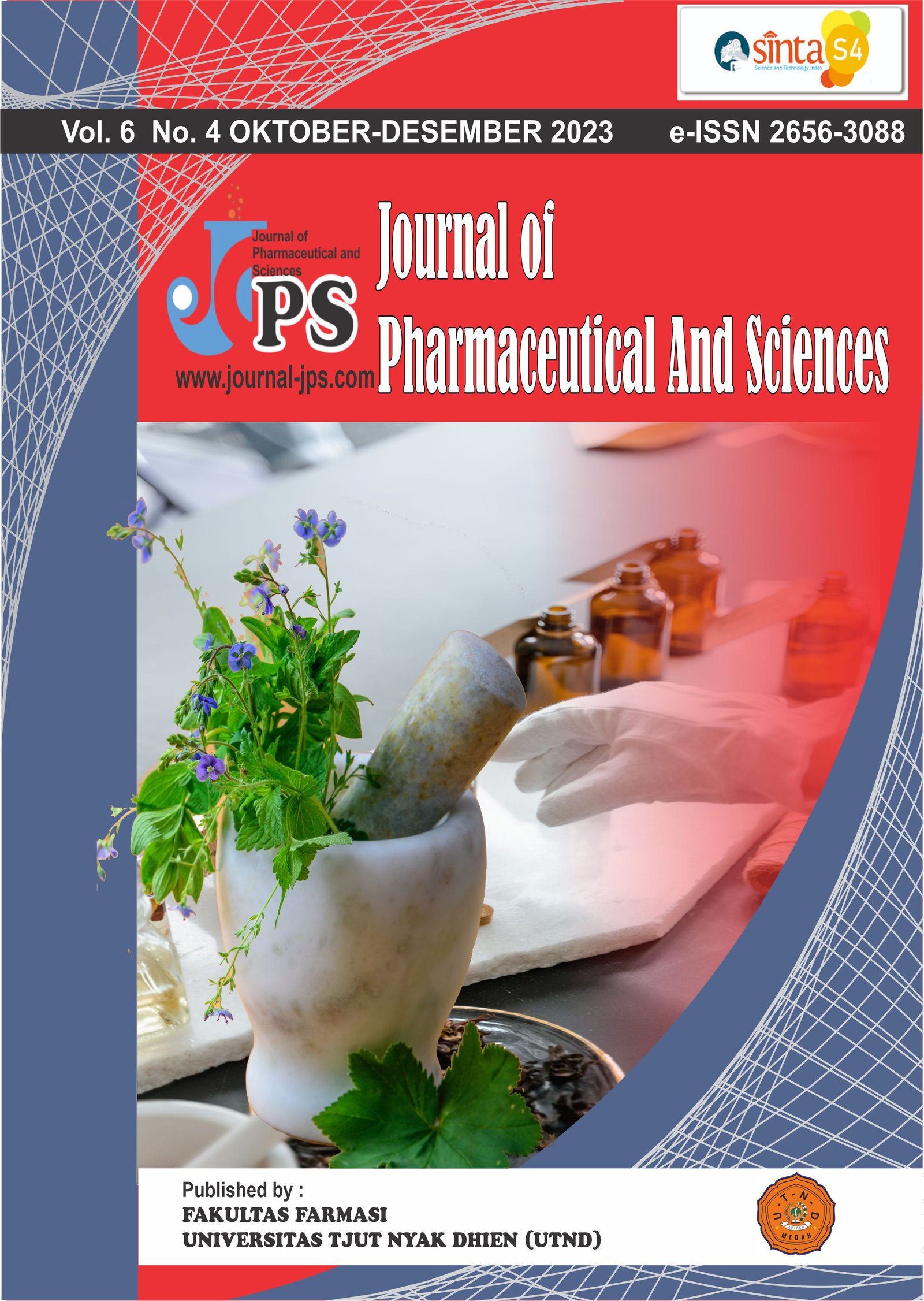Acute Toxicity Test of White Turi Flower (Sesbania grandiflora (L.) Pers.) Ethanol Extract on SGOT and SGPT Parameters in the Liver of Wistar Strain Male White Rats (Rattus norvegicus)
Main Article Content
Page: 1578-1589
Abstract
Turi plants contain phenolic compounds, tannins, flavonoids, alkaloids, and glycosides. In addition, Turi plants also contain potentially toxic compounds such as pyrrolizidine compounds. This study aimed to determine the acute toxicity of ethanol extract of white turi flowers on toxic symptoms, macroscopic observation of liver organs, and measurement of SGOT and SGPT levels. This type of research is a laboratory experimental study using the Post Test Only Control Group Design research design. Rats were divided into four groups: standard control, 10,000, 15,000, and 20,000 mg/kgBB, then observed for toxic symptoms, liver macroscopic, and SGOT-SGPT levels. Phytochemical test results showed that turi flowers contain alkaloid, saponin, tannin, steroid, and triterpenoid compounds. Macroscopic observation of the liver showed normal condition. The results of the One-way ANOVA test on SGOT and SGPT levels showed significant differences in each group. Based on the results of the study, it can be concluded that there is toxicity of ethanol extract of white turi flower to rats seen from toxic symptoms that appear but have not caused death in rats. Besides that, white turi flower extract can affect increasing SGPT and SGPT levels
Downloads
Article Details

This work is licensed under a Creative Commons Attribution-NonCommercial-ShareAlike 4.0 International License.
References
Arunabha, M and Satish, N. (2014). “Evaluation of Immunomodulatory Activity of Sesbania grandiflora Flowers Extract in Mice.” Indonesian Journal of Pharmacy 25(4):277. doi: 10.14499/indonesianjpharm25iss4pp277.
Aulia, F. N. (2019). “Uji Toksisitas Subkronik Kombinasi Ekstrak Etanol Daun Mangga Pakel Dengan Daun Pandan Wangi Terhadap Kadar SGOT dan SGPT Tikus.” Skripsi. Fakultas Farmasi, Universitas Jember.
Badan Pengawas Obat dan Makanan Republik Indonesia (BPOM RI). (2022). “Peraturan BPOM Nomor 10 Tahun 2022 Tentang Pedoman Uji Toksisitas Praklinik Secara in Vivo.”
Datu, F. N. S., Hasri, H., Pratiwi, D. E. (2021). “Identifikasi Dan Uji Kestabilan Tanin Dari Daging Biji Pangi (Pangium Edule Reinw.) Sebagai Bahan Pewarna Alami.” Chemica: Jurnal Ilmiah Kimia Dan Pendidikan Kimia 22(1):29. doi: 10.35580/chemica.v22i1.21726.
Habibi, A.I., Firmansyah, R. A., and Setyawati, S. M. (2018). “Skrining Fitokimia Ekstrak n-Heksan Korteks Batang Salam (Syzygium polyanthum).” Indonesian Journal of Chemical Science 6(2).
Hasana, A. N., Sitasiwi, A. J., and Isdadiyanto, S. (2019). “Hepatosomatik Indeks dan Diameter Hepatosit Mencit (Mus musculus L.) Betina Setelah Paparan Ekstrak Etanol Daun Mimba (Azadirachta indica Juss.).” Pro-Life 6(1):1. doi: 10.33541/pro-life.v6i1.931.
Hasanah, M. (2022). “Uji Toksisitas Ekstrak Kulit Batang Turi Putih (Sesbania grandiflora (L.)Pers.) Menggunakan Pelarut Etanol Terhadap Organ Hati (SGOT-SGPT) Mencit (Mus Musculus).” Skripsi. Program Studi Teknologi Laboratorium Medis, Fakultas Ilmu Kesehatan, Universitas Muhammadiyah Sidoarjo.
Ih, H., Fajriaty, I., Rahmawani, S.P., and Abdurrachman. (2017). “Skrining Fitokimia dan Analisi Kromatografi Lapis Tipis dari Ekstrak Etanol Herba Pacar Air (Impatiens balsamina Linn.).” Seminar Nasional Pendidikan MIPA dan Teknologi IKIP PGRI Pontianak. pp. 403–414.
Jumain, J., Syahruni, S and Farid, F. (2018). “Uji Toksisitas Akut dan LD50 Ekstrak Etanol Daun Kirinyuh (Euphatorium odoratum Linn) pada Mencit (Mus musculus).” Media Farmasi 14(1):28. doi: 10.32382/mf.v14i1.82.
Mustapa, M. A., Toluli, T. S., and Mooduto, A. M. (2018). “Uji Toksisitas Akut yang Diukur Dengan Penentuan LD50 Ekstrak Etanol Bunga Cengkeh (SYZYGIUM AROMATICUM L.) Terhadap Mencit (Mus Musculus) Menggunakan Metode Thompson-Weil.” Frontiers: Jurnal Sains dan Teknologi 1. doi: 10.36412/frontiers/001035e1/april201801.10.
Nainggolan, M., Ahmad, S., Pertiwi, D., and Nugraha, S. E. (2019). Penuntun Dan Laporan Praktikum Fitokimia. Medan: Universitas Sumatera Utara.
Nani, S., Bodhi, W., and Simbala, H. (2017). “Pengaruh Ekstrak Etanol Buah Pinan Yaki ( Areca vestiaria ) Terhadap Gambaran Makroskopis Organ Ginjal pada Tikus Putih Jantan Galur Wistar (Rattus norvegicus).” Pharmacon Jurnal Ilmiah Farmasi 6(3). doi https://doi.org/10.35799/pha.6.2017.16580.
Prayoga, D. G. E., Nocianitri, K.A., and Puspawati, N. N. (2019). “Identifikasi Senyawa Fitokimia dan Aktivitas Antioksidan Ekstrak Kasar Daun Pepe.” Jurnal Ilmu Dan Teknologi Pangan (ITEPA) 8(2):111. doi: 10.24843/itepa.2019.v08.i02.p01.
Purwaningsih, S., Handharyan, E., and Lestari, I. R. (2015). “Pengujian Toksisitas Sub Akut Ekstrak Hipokotil Bakau Hitam pada Tikus Galur Sprague Dawley.” Jurnal Akuatika VI(1):30-40.
Rohmah, J., Rachmawati, N. R., and Nisak, S. (2018). “Perbandingan Daya Antioksidan Ekstrak Aseton Daun Dan Batang Turi Putih (Sesbania Grandiflora (L.) Pers) Denagn Metode DPPH (Diphenilpycrylhydrazil).” Prosiding Seminar Nasional Hasil Riset Dan Pengabdian (SNHRP-1) 665–77.
Rosida, Azma. 2016. “Pemeriksaan Laboratorium Penyakit Hati.” Berkala Kedokteran 12(1):123. doi: 10.20527/jbk.v12i1.364.
Schrenk, D., Gao, L., Lin, G., Mahony, C., Mulder, P. P. J., Peijnenburg, A., Pfuhler, S., Rietjens, I. M. C. M., Rutz, L., Steinhoff, B., and These, A. (2020). “Pyrrolizidine Alkaloids in Food and Phytomedicine: Occurrence, Exposure, Toxicity, Mechanisms, and Risk Assessment - A Review.” Food and Chemical Toxicology 136:111107. doi: 10.1016/j.fct.2019.111107.
Stevani, H. (2016). Praktikum Farmakologi. Jakarta: Kementrian Kesehatan Republik Indonesia.
Sulastra, C. S., Khaerati, K., and Ihwan. (2020). “Toksisitas Akut dan Lethal Dosis (LD50) Ektral Etanol Uwi Banggai Ungu (Dioscorea alata L.) Pada Tikus Putih (Rattus norvegicus).” Jurnal Ilmiah Medicamento 6(1). doi: 10.36733/medicamento.v6i1.715.
Sumayya. (2010). “Uji Toksisitas Akut Ekstrak Air Daun Turi (Sesbania Grandiflora (L).Pers) Pada Embrio Ikan Zebra (Danio Rerio).” Skripsi. Program Studi Farmasi, Fakultas Matematika dan Ilmu Pengetahuan Alam, Universitas Islam Indonesia Yogyakarta.
Ubang, F., Siregar, V. O., and Herman, H. (2022). “Efek Toksik Pemberian Ekstrak Etanol Daun Mekai (Albertisia Papuana Becc.) Terhadap Mencit: Toxic Effects of Mekai (Albertisia Papuana Becc.) Leaf Ethanol Extract on Mice.” Proceeding of Mulawarman Pharmaceuticals Conferences 16:49–57. doi: 10.25026/mpc.v16i1.672.
Wicaksono, H. S., Narayani, I., and Iriani Setyawati. (2015). “Structure of Mice Liver After Giving Red Calliandra Leaf Extract.” Jurnal Simbiosis III(1):258–68.
Wiedenfeld, H. (2011). “Plants Containing Pyrrolizidine Alkaloids: Toxicity and Problems.” Food Additives & Contaminants: Part A 28(3):282–92. doi: 10.1080/19440049.2010.541288.
Wijaya, A., and Noviana. (2022). “Penetapan Kadar Air Simplisia Daun Kemangi (Ocimum basilicum L.) Berdasarkan Perbedaan Metode Pengeringan.” Jurnal Riset Kefarmasian Indonesia, 4(2). doi: https://doi.org/10.33759/jrki.v4i2.246.
Wijaya, H., Jubaidah, S., and Rukayyah, R. (2022). “Perbandingan Metode Ekstraksi Maserasi Dan Sokhletasi Terhadap Rendemen Ekstrak Batang Turi (Sesbania grandiflora L.).” Indonesian Journal of Pharmacy and Natural Product 05(01):1–11. doi: https://doi.org/10.35473/ijpnp.v5i1.1469.





